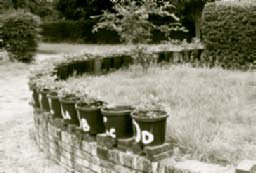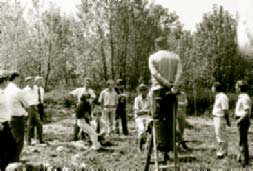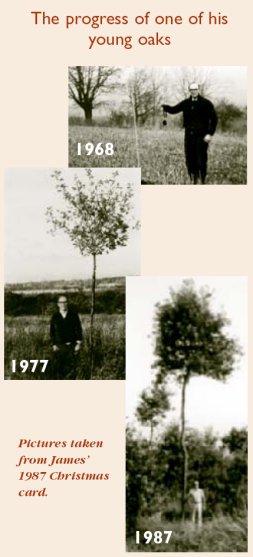With the passing of James in July, I now feel able to spread the word about our late patron’s remarkable tree growing and experiments so that others can learn from his work. If he were still alive, James would have been unwilling to publish his views because he always reckoned it would take 30 years to prove his theories. In 1947, James took over the family farm set in the beautiful Stour valley, with his cousin by marriage. James (34) looked after the woods, hedges and ditches, whilst his partner did all the practical farm management.
I was first introduced to James in 1975 by George Green who had worked with James on his willow plantations for many years and which numbered 1,600 trees by then. The owner confronting me was very direct - startlingly so - friendly and extraordinarily enthusiastic about his trees. In my capacity as round timber buyer for our family firm of Suffolk cabinet-makers, I was actually a predator - a man on the lookout for prime trees. Yet James was a lover of young trees, having no time for mature and moribund specimens. "Cut it down and it will give me so much room to plant my young ones", he would say. I warmed to him very quickly!
Boxted oaks "hardening off" outside James’ back door.
James was not content just to sell his mature trees to a cabinet-maker, he wanted to see what we made, how we made it and insisted on meeting our staff at both sawmill and workshops. What is your optimum length for an oak veneer butt ? What girth should my wild cherry be ? Will the stain on my sweet chestnut cause problems ? And so on. Filled with this information, off he would go and high prune like mad - an attack of "the ups" is how he would describe it!
Fortunately, James kept meticulous records in his famous "Tree Book" - a huge tome which would always be near at hand, even in the woods, usually on the seat of his battered Range Rover. It contained notes of plantings, measurements, observations of all kinds, policy thoughts for that year, but above all photographs of his trees and their progress. It was his most practical and perfect tool.
Writing an article for the CLA in 1985 James warned "I did not realise at the time how massive my planting programme must be. Mine is the only labour available, all the work has to be within my physical power - and this is one of the points that I have proved to my own satisfaction; it is possible for a 67 year old man to plant, establish and bring to a condition ready for the future, valuable self-standing hardwood trees".
During our early years of working together, James taught me a lot about raising good quality trees. Pretty soon the "planting bug" grew within me and The Predator weakened. Being now overtaken with a thirst for more forestry knowledge, I joined the Royal Forestry Society’s East Anglian Division (covering Suffolk, Norfolk and Cambridgeshire) meeting other expert tree growers and lapping up the information and camaraderie. But I simply did not know enough to challenge The Accepted Word, even when I had my doubts about a certain piece of forestry. I needed a hit man at my side, and who better than the man from Boxted Hall ! James, living just across the border in Essex, had to be granted special permission by the R.F.S. to join the East Anglian Division and within minutes of arriving at his first woodland meeting, made a dramatic impact by questioning just about everything in the nicest possible way - smiling, then backing down.
Afterwards, members came up to enquire who my companion was and where did he come from ? Well, over the years James was fondly accepted by everyone and whenever he was unable to attend a meeting, it was usually a pretty uneventful one. He had the knack of "stirring things up", not maliciously, but James always made people think deeply and the ensuing debate was invariably humorous.
The East Anglian Division came to Boxted Hall in 1975, planted a commemorative tree (which died) - came again in 1988 when he ruthlessly high pruned perfect trees until his guests pleaded for mercy.
I persuaded him to join us on a week’s trip to Denmark in 1991, where we had a memorable time in the company of knowledgeable foresters and generous hosts. It rained buckets but James thrived, just like his young trees.
The woodlands at Boxted were host to one of the most important forestry events in 1992 when the National R.F.S. meeting was held in Suffolk and Essex. James had planned for months ahead and was, as ever, meticulous with his programme. Wearing a bright red sunhat and carrying a portable stepladder, he delivered his theories at every stop - just like a speaker at Hyde Park Corner. Then he would both amaze - and appal - his audience with a sudden and vigorous attack of high pruning on some unsuspecting 20 year old oak in the June heat. He was unstoppable. Everyone present (and there were at least 100) had a marvellous day and went away with their pre-conceived forestry thoughts seriously challenged by his deep thinking and outrageous experiments.
At the final presentation, the R.F.S. president, having given a vote of thanks, proposed that James Blewitt’s Boxted Hall Estate be nominated for the new Forestry Commission’s "Centre of Excellence" Award. Everyone present approved this splendid idea. Several weeks later, I took a telephone call from James who was laughing so much that he could hardly read the Forestry Commissioner’s letter - a letter which informed him that they could not see fit to make the proposed award for a variety of reasons (which, to this day, are quite incomprehensible). Instead, they gave it to a young farmer and his wife who had planted up about 10 acres of farmland with hardwoods three years previously! James was truly amused by that decision and said that perhaps he really ought to toe the Official Forestry Line and stop experimenting. Fat chance.
History books are littered with stories of how eccentric British characters have been ignored by those in authority, yet here we have another example. Certainly, James was eccentric. But he was also highly intelligent, scientific in his approach and carried out experiments on trees which he knew would need testing with the passage of time.
Sadly, James was never given that time, for in his latter years he suffered from dementia and was cared for by his family, finally passing quietly away this year.
It is certainly true that Woodland Heritage would not have been founded without James Blewitt’s influence and enthusiasm for trees and forestry. We owe him a huge debt.
Peter Goodwin



